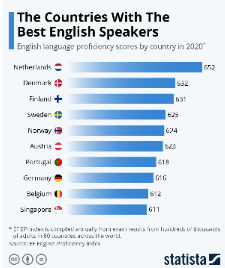America’s Language Deficit
May 20, 2022
View this articles animation, by Kaitlyn Murphy, here!
Learning a second language comes with many benefits. In most countries, the opportunity to learn a second language is offered, America being one of them, so why are Americans so far behind other countries when it comes to knowing a second language? According to Chapter 4 of the Pennsylvania Code, all Pennsylvania schools students are required to take at least two years of language education. Most schools offer levels of Spanish, German, Mandarin, and French. These classes are offered because they promote improvement on one’s memory, communication skills, and mental flexibility. In most U.S schools, students begin taking language courses in middle school, which may be contributing to the minimal amount of students that come out of highschool speaking another language. According to The Atlantic, “Less than 1 percent of American adults today are proficient in a foreign language that they studied in a U.S. classroom”. If language classes in America are required, why are so few people fluent?
Why are American students so behind other countries in language? Is it because we don’t take it seriously enough, or are we just not learning it correctly? In order to get the best results, students should start learning a foregin language around the age of 10. In comparison, in European countries, schools start teaching a second language when their students are between the ages 6 through 9. According to International Business Seminars, Europeans view learning a second language as “A necessity rather than a luxury because of the proximity of countries to one another ”. Could this be a possible reason Americans are so far behind everyone else in language skills? In response to this question, the U.S. The Census Bureau states that over a third of people in the UK are bilingual while “only 20 percent of Americans can converse in two or more languages, compared with 56 percent of Europeans”. Maybe if America viewed language as a necessity and not only as an addition to college applications we would see more Americans fluent in languages other than English.
second language as “A necessity rather than a luxury because of the proximity of countries to one another ”. Could this be a possible reason Americans are so far behind everyone else in language skills? In response to this question, the U.S. The Census Bureau states that over a third of people in the UK are bilingual while “only 20 percent of Americans can converse in two or more languages, compared with 56 percent of Europeans”. Maybe if America viewed language as a necessity and not only as an addition to college applications we would see more Americans fluent in languages other than English.
Learning a second language opens up more opportunities in the workfield and life. Many jobs have multinational employees, and being bilingual not only enhances communication, but according to Mondly Blogs, it creates creative, more intelligent employees because “the ability to speak more than one language shapes the brain’s capability of thinking outside the box and thinking up innovative ways to solve problems”. Language is so beneficial, yet not taken  seriously by Americans. America’s language deficit comes from the belief that another language simply isn’t needed. Afterall, English is one of the most spoken languages worldwide with millions of speakers. Most people who travel to America are already fluent in English or are in the process of learning it, so Americans no longer feel the need to put the same amount of effort into communication skills. As English proceeds to become more common, Americans grow lazier. It appears as if they believe that as long as other countries are bilingual, there is no longer a reason for them too as well.
seriously by Americans. America’s language deficit comes from the belief that another language simply isn’t needed. Afterall, English is one of the most spoken languages worldwide with millions of speakers. Most people who travel to America are already fluent in English or are in the process of learning it, so Americans no longer feel the need to put the same amount of effort into communication skills. As English proceeds to become more common, Americans grow lazier. It appears as if they believe that as long as other countries are bilingual, there is no longer a reason for them too as well.
Language classes don’t challenge students enough to put themselves in a situation where they’re forced to speak another language. One of the best ways to learn a language is through exposure. By putting students in situations where their language skills are challenged they form connections to that language, hence making it easier to learn.



